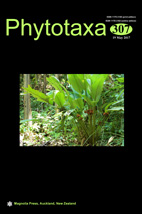Abstract
The new combination Wurmbea novae-zelandiae was recently made based on published phylogenetic studies, but little information was provided on its relationships based on morphology. This species was originally described as Anguillaria novae-zelandiae, for which a lectotype is designated. Morphological characters of W. novae-zelandiae are re-evaluated and shown to be characteristic of Wurmbea, thereby supporting the revised generic placement. However, W. novae-zelandiae differs from all other Wurmbea species in its diminutive stature, fewer tepals and stamens, and variable floral morphology, with 1–3 carpels, often leaf-like tepals, and aberrant tepal shape and number. DNA sequence data places W. novae-zelandiae as the sister species of W. uniflora, a species not included in earlier phylogenetic studies. These two species share mostly solitary flowers with white tepals, nectaries two per tepal and similar in form and position, small yellow anthers, and styles that are relatively short and recurve as flowering proceeds, with the inner style surface stigmatic for up to half of its length. A revised generic description of Wurmbea is provided to take account of the recently widened concept.

